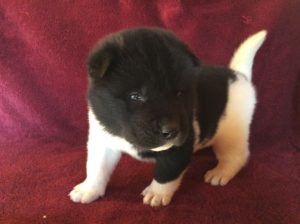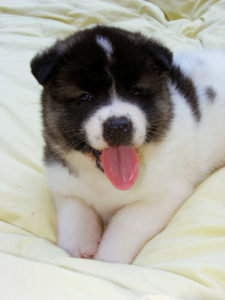Bringing Your Puppy Home

Use the information in this section to prepare your home and family for life with your new puppy.
The Supplies You Need
Before you bring your puppy home, be sure you have the following supplies:
- Premium pet food to get your new puppy off to a good start . NUTRO / Max Puppy Food (dry kibble) and canned Nutro Max puppy food is what the puppy eats (will be eating) here at RH AKITAS. Also used in addition to these is Pedigree Puppy Food dry kibble and canned Pedigree Puppy food to insure new owners that do not have access to Nutro brand have access to a common brand redily available.
- Stainless steel, non-tip food and water bowls.
- Identification tags with your puppy’s name, your name, phone number and your veterinarian’s name and phone number. A collar and a leather or nylon 6-foot leash that’s 1/2 – 3/4 inches wide (consider using a “breakaway” collar with plastic clips that will unsnap in case your puppy gets hung up on something).
- A home and travel crate that’s airline approved and will accommodate your puppy’s adult size. This crate will serve as your puppy’s new “den” at home, when traveling or riding to the veterinarian’s office. His scent in the crate will provide comfort and a sense of security during these stressful times. Some akita pups may reject the enclosed area of the fiber glass / plastic type kennels. After all – akitas favorite thing to do is to be with his family. Using a metal wire cage works best for pups that are uncomfortable in an enclosed kennel. Purchase a larger wire cage so you pup can grow into adulthood using the same cage!
- Stain remover for accidental soilings.
- Brushes and combs suited to your puppy’s coat; insure you purchase long toothed brushes and combs so you can reach all the way through their thick coat. Dense brushes will not work on an akita. They will simply glide on the top of the fur patting it down.
- Dog shampoo, toothbrush and paste for dogs.
- High-quality, safe chew toys to ease teething. Its not recommended you use raw hide during the first year of the dogs growing period. Use raw hide treats sparingly. Too much can hurt your dog.
- Flea, tick and parasite controls. (insure product is for the age of the dog)
- Nail clippers. Get the best to make this process easier for your Akita. Cheapoes crush the nail vs slicing through it like butter.
- Healthy Treats

Helpful Hints
- Use stainless steel, non-tip food bowls, which won’t break or absorb odors.
- Toys with parts that squeak or whistle can be dangerous if swallowed.
- For a comfortable collar fit, allow for two-fingers of space between the collar and your dog’s neck; consider using an adjustable collar.

Making a Home Safe
To make your home safe for your new puppy, eliminate potential hazards around the house and pay attention to the following items:
- Keep breakable objects out of reach.
- Deny access to electrical cords by hiding or covering them; make outlets safe with plastic outlet plugs.
- Safely store household chemicals.
- Keep the following house and garden plants out of reach: poinsettias, azaleas, rhododendrons, dumb cane, Japanese yew, oleander and English ivy among others.
- In the garage, be sure engine lubricants and other poisonous chemicals (especially antifreeze) are safely stored.
- If you own a pool or hot tub, check the cover or the surrounding fence to be sure they’re in good condition.
- If you provide your puppy with an outdoor kennel, place it in an area that provides sun and shelter in the pen; be sure the kennel is large enough to comfortably accommodate your puppy’s adult size.

The First Days at Home
The ideal time to bring home a new puppy is when the house is quiet. Discourage friends from stopping by and don’t allow overnight guests. First establish a daily routine and follow these steps:
Step 1: Before bringing him in the house, take him to the area in your yard that will serve as his “bathroom” and spend a few minutes there. If he goes, praise him. If not, proceed into the house but be sure to take him to this spot each time he needs to use the bathroom.
Step 2: Take him to the room that accommodates your crate—this restricted area will serve as his new “den” for several days. Put bedding and chew toys in the crate, leave the door open and line the area outside of the crate with newspaper, in case of an accident. Let him investigate the crate and the room. If he chews or urinates on his bedding, permanently remove it from the crate.
Step 3: Observe and interact with your puppy while he’s acclimating to his new den. This will help forge a sense of pack and establish you as the pack leader.
Special Puppy Concerns
Don’t treat a puppy as young as 6 to 12-weeks old like an adult dog. Treat him the same way you would your own infant: with patience, constant supervision and a gentle touch. The way you interact with your puppy at this age is critical to his socialization. Use these tips:
- Don’t bring home a puppy while you’re on vacation so you can spend a lot of time with him. Instead, acclimate him to your normal, daily routine. (suggestion only not necessary)
- Supervise your puppy at all times and interact with him regularly.
- Be alert for signs (sniffing and circling) that he has to go to the bathroom, then take him outside immediately.
- A young puppy has no bladder control and will need to urinate immediately after eating, drinking, sleeping or playing. At night, he will need to relieve himself at least every three or four hours.
- Don’t punish an accident. Never push his nose in the waste or scold him. He won’t understand, and may learn to go to the bathroom when you’re out of sight.
- Praise your puppy every time he goes to the bathroom outside.
- Feed your puppy a formula designed for puppies. Like a baby, he needs nutritious, highly digestible food.

Meeting Resident Pets
Keep resident pets separated from your new puppy for a few days. After your new puppy is used to his new den area, put an expandable pet gate in the doorway or put your puppy in his crate. Give your resident pet access to the area. Let pets smell and touch each other through the crate or pet gate. Do this several times over the next few days. After that, give the resident pet access to the den area with your new puppy out of his crate. Supervise their meeting and go back to through-the-gate/crate meetings if trouble arises.

Take Delivery of your Pup
Your pup is still young and has a small bladder. Also, he/she is still developing and experiencing new situations and experiences. Traveling for your pup is a new experience and whether by car or plane – the motion of travel is a new experience that sometimes causes brief upset stomach, diarrhea due to stress and nervousness. All symptoms should dissipate within 24 hours or less, diarrhea taking the longest.
Clean-up. Extra paper towels or infant wipes work great in cleaning up accidents from surfaces in the car or messes on your pup.
Your puppy needs to be constantly consoled and at times (although not the safest way to have your pup in the car) carried in your arms during your trip. If you need to stop to let your pup relieve him/herself DO NOT LET YOUR PUPPY GAIN EXPOSURE TO DOG FESES. Seriously! Although your pup has his/her first puppy shots – there have been instances that parvo was still contracted by exposure to enough virus particles by infected dog stools. Keep watch over your pup during walks.
Your puppy will miss his mom and litter mates the first few nights. The pup may howl and cry for attention during the night. This is normal and just a way it goes in getting a new pup. Some are more vocal than others. Using a toy and or blanket from his first home helps a lot.
Feeding –Use the complimentary bag of food to wean your puppy slowly to the food of your choice. The pup’s stomach is sensitive at this point. Loose stool is common but not diarrhea. Keep close contact with your vet and be sure to get your pup looked at within 48 hours of having him at your new home.
Enjoy.






 Important types of fatty acids
Important types of fatty acids


